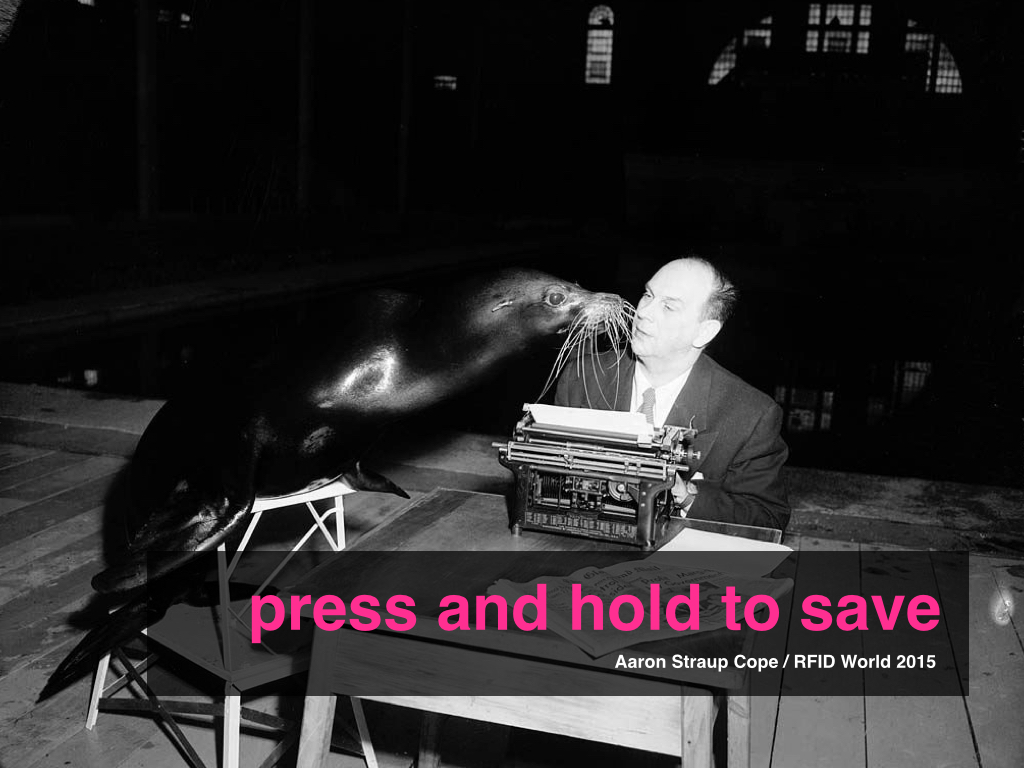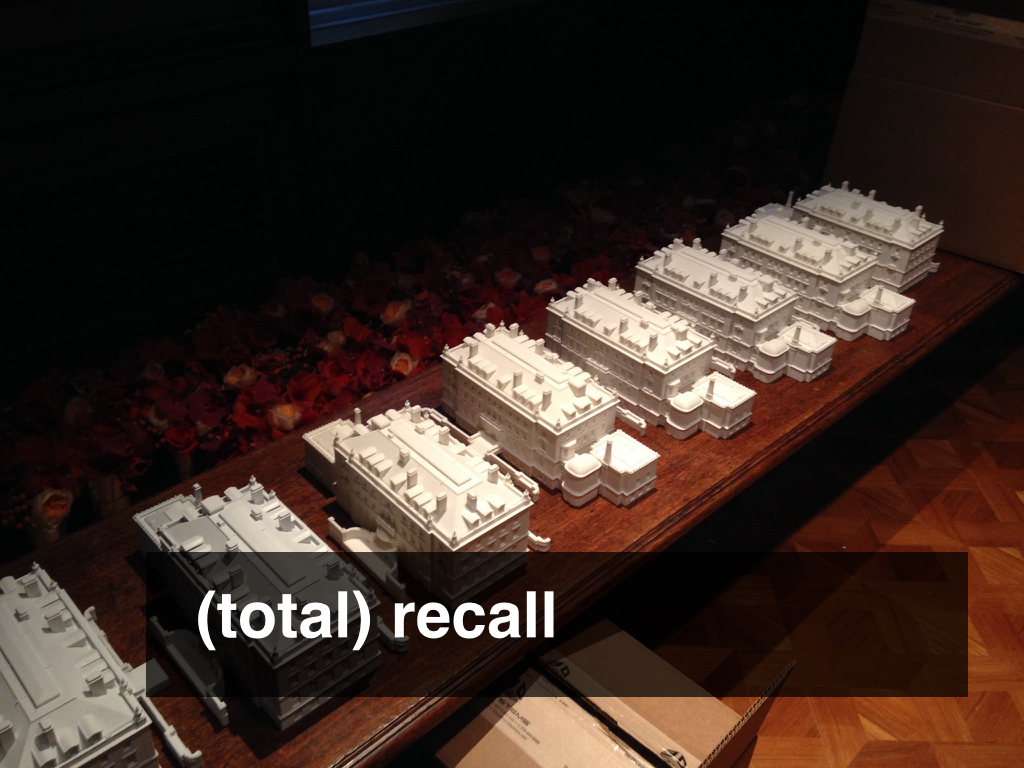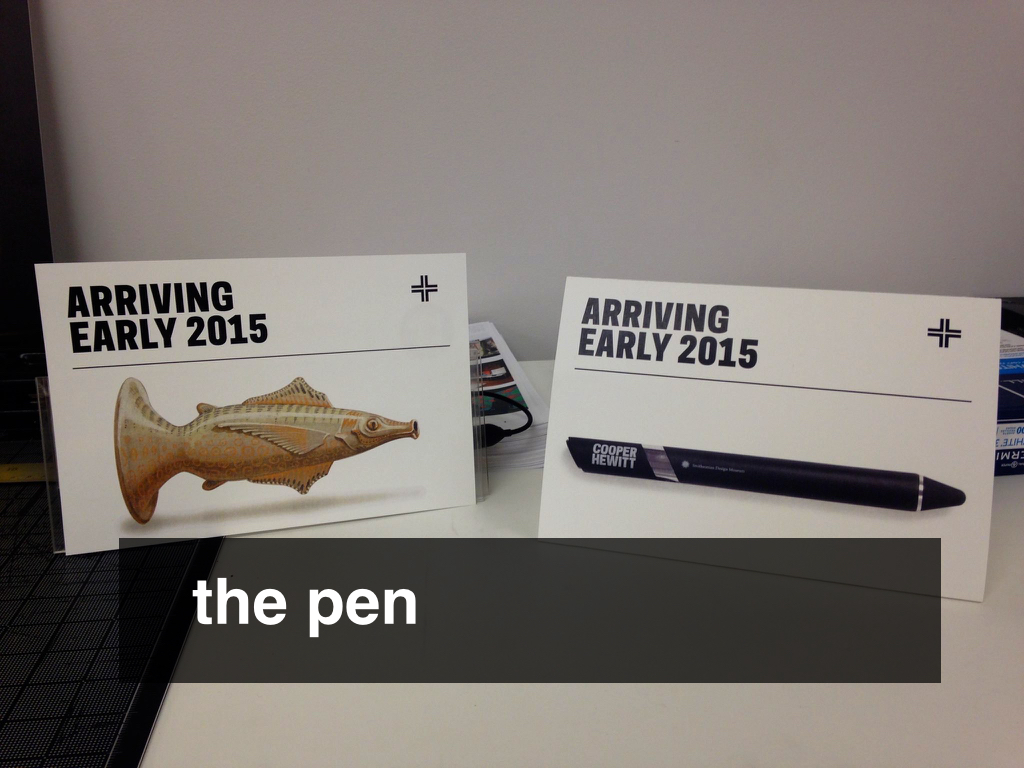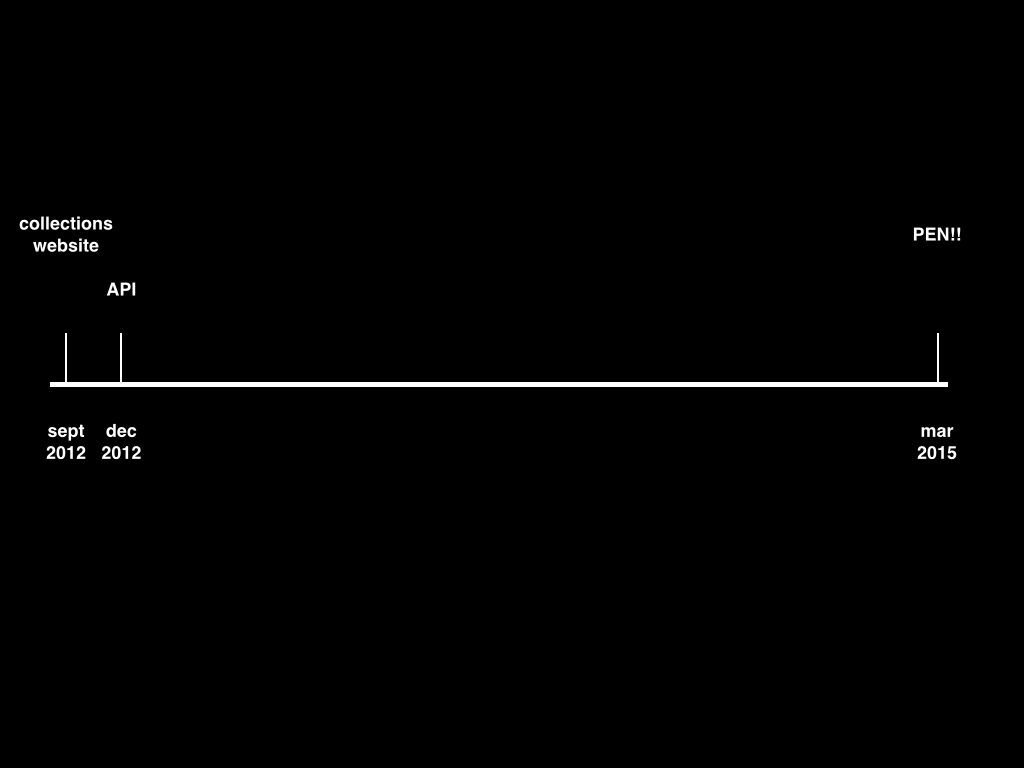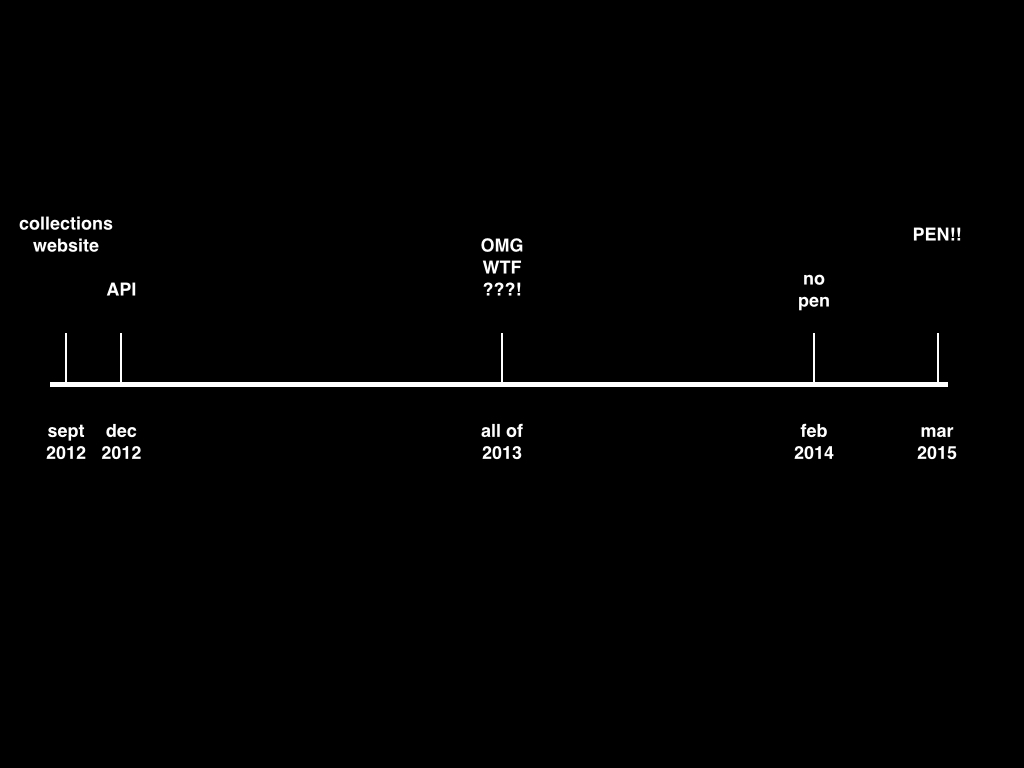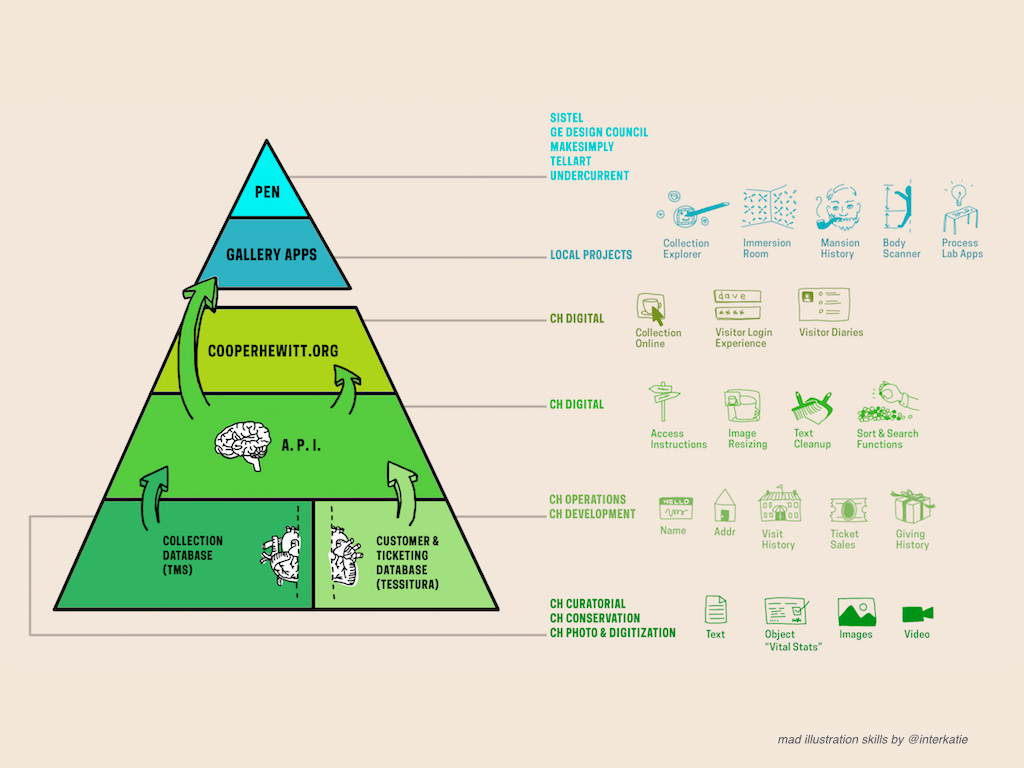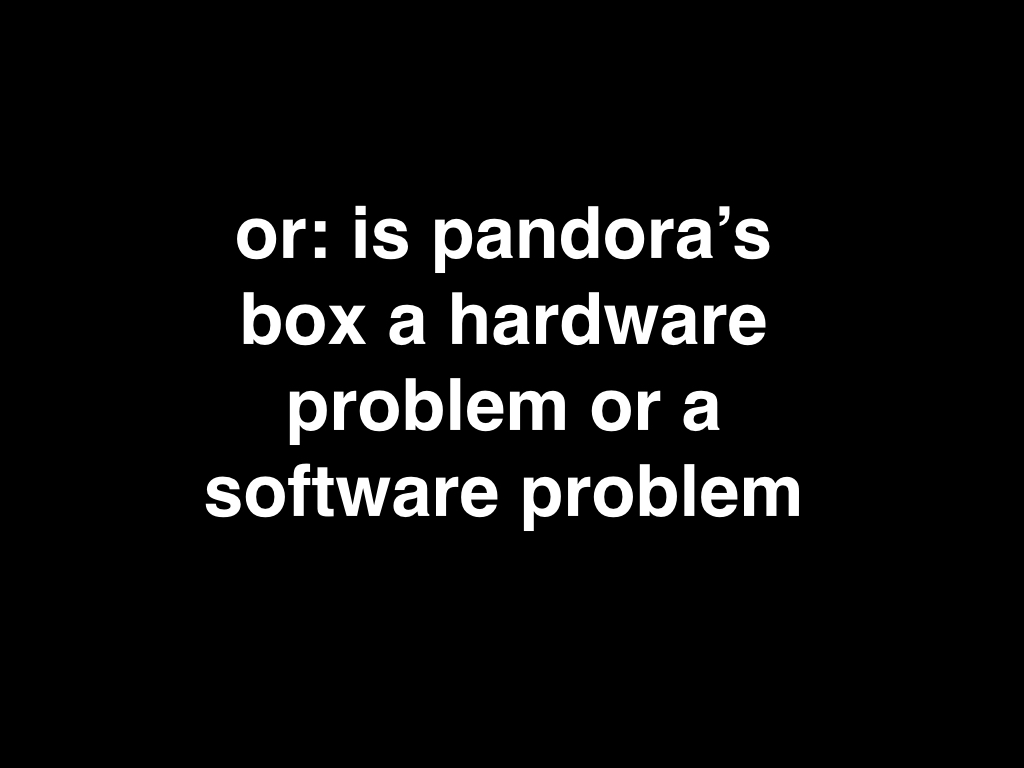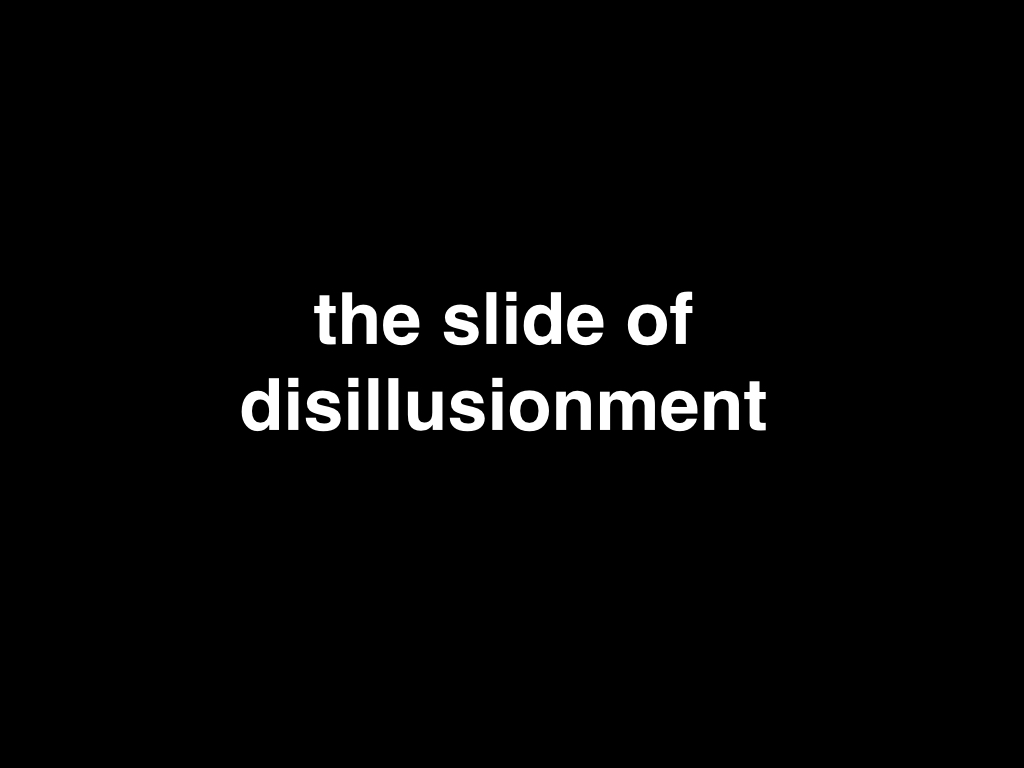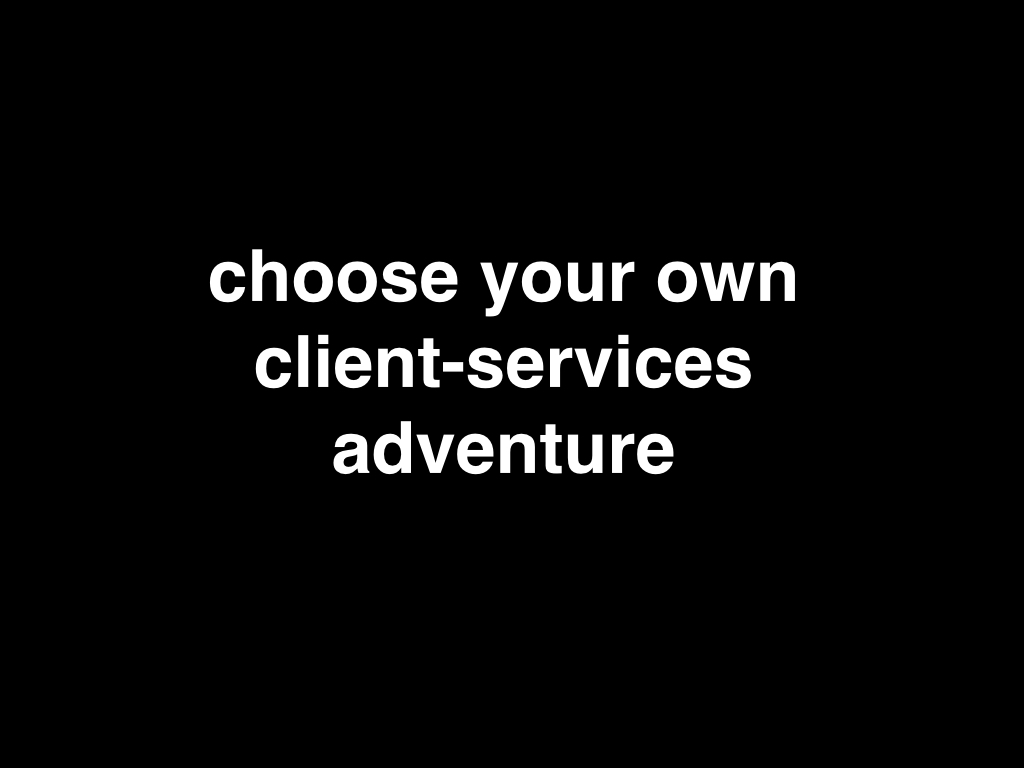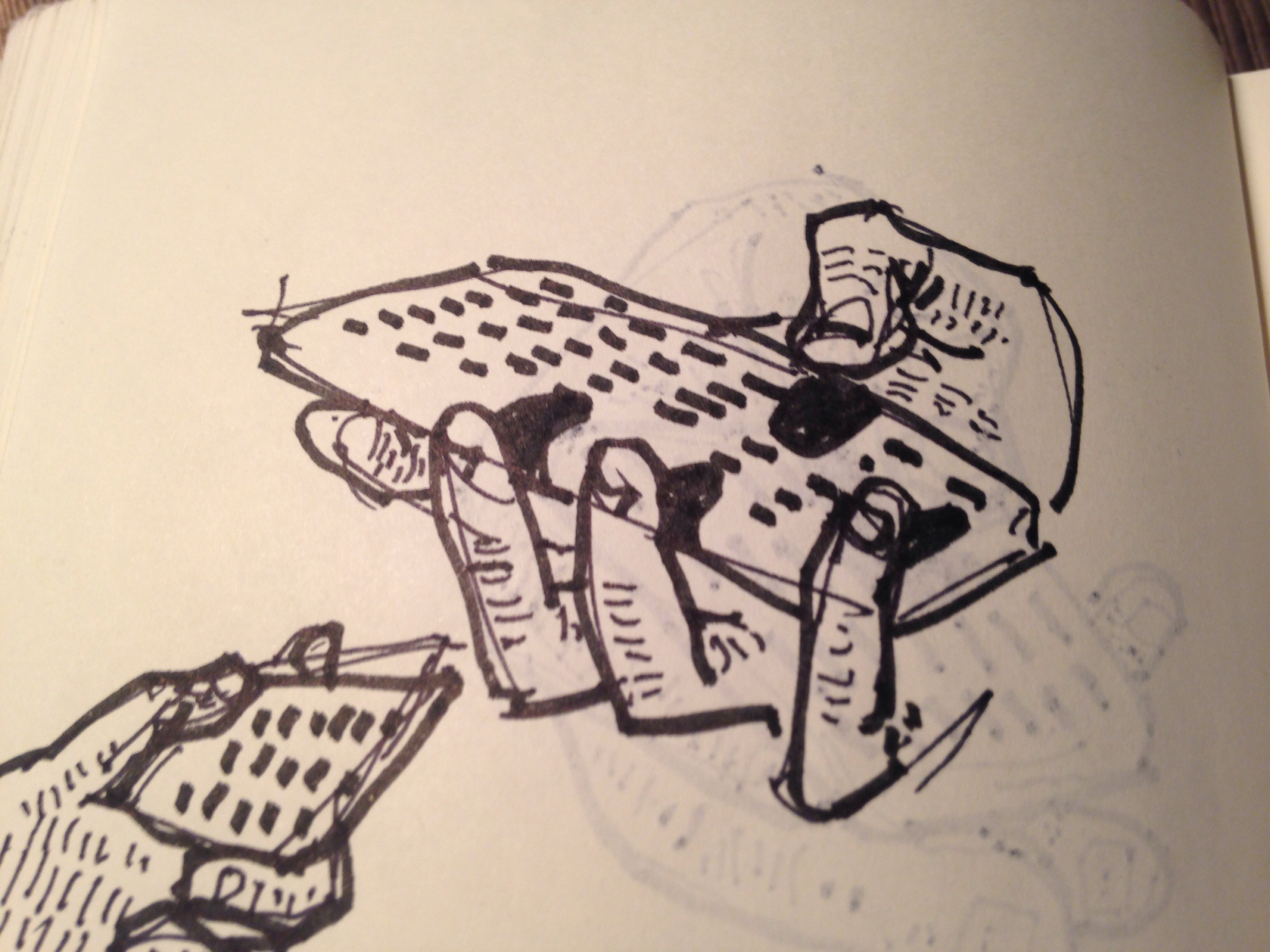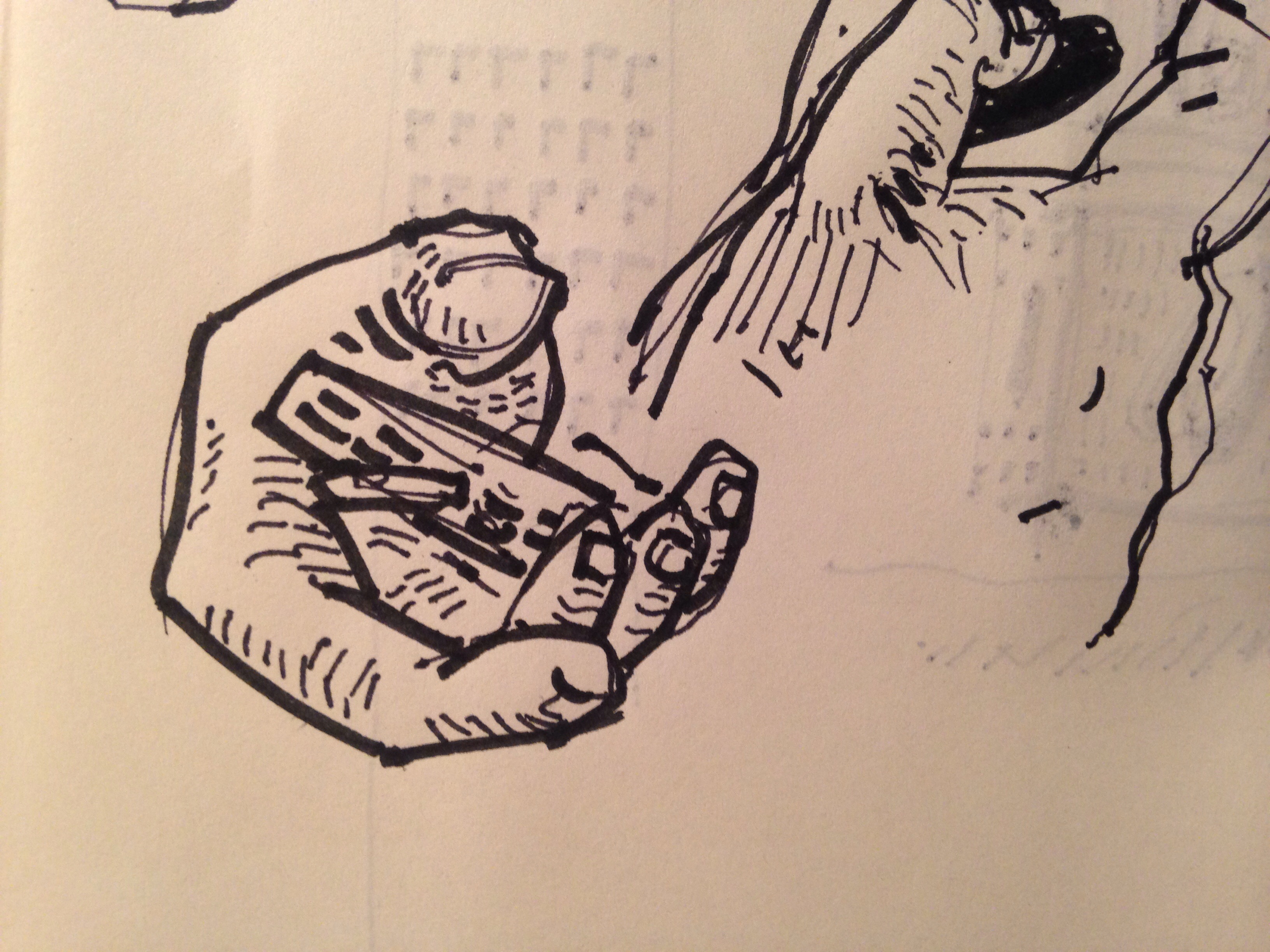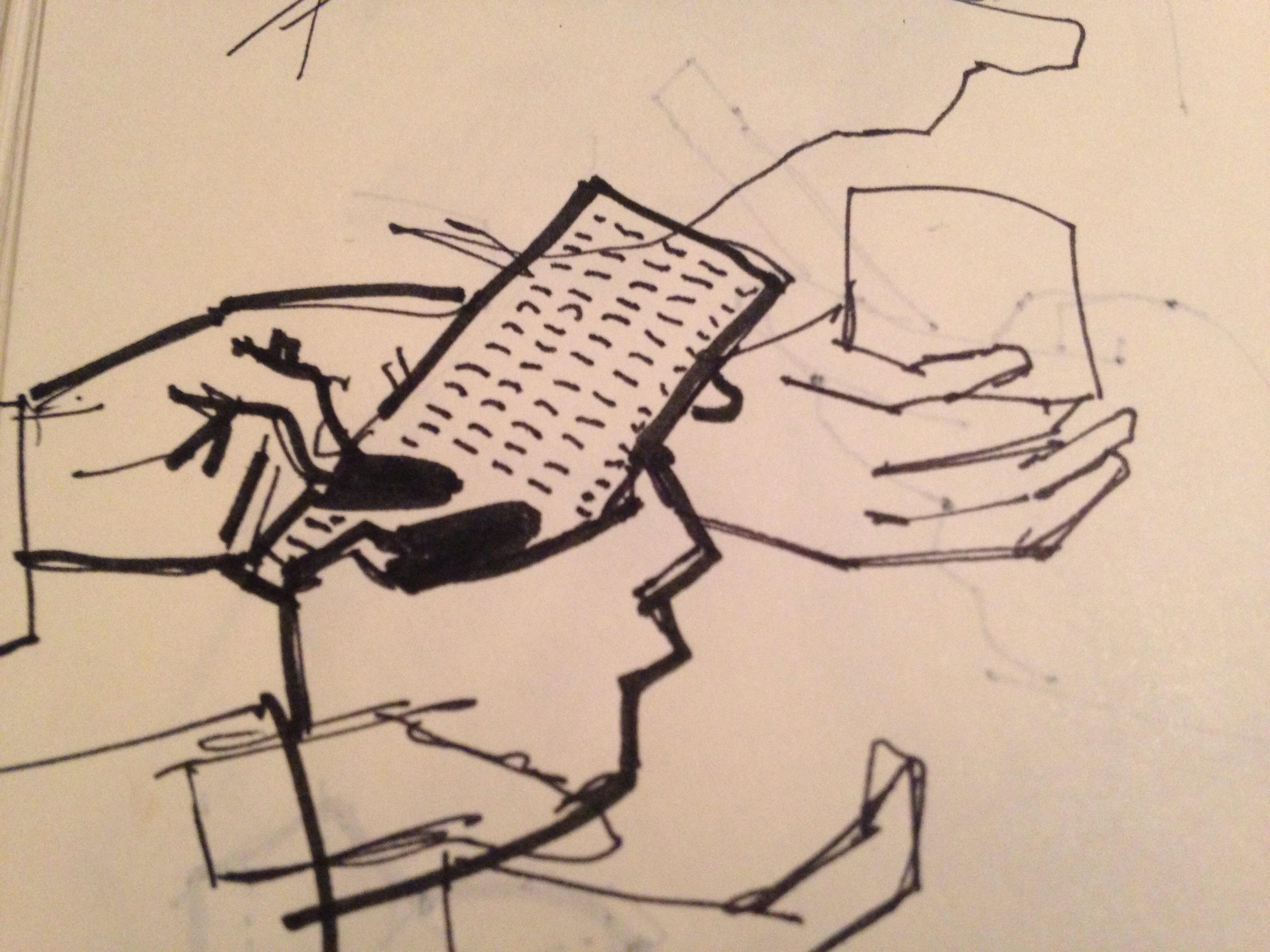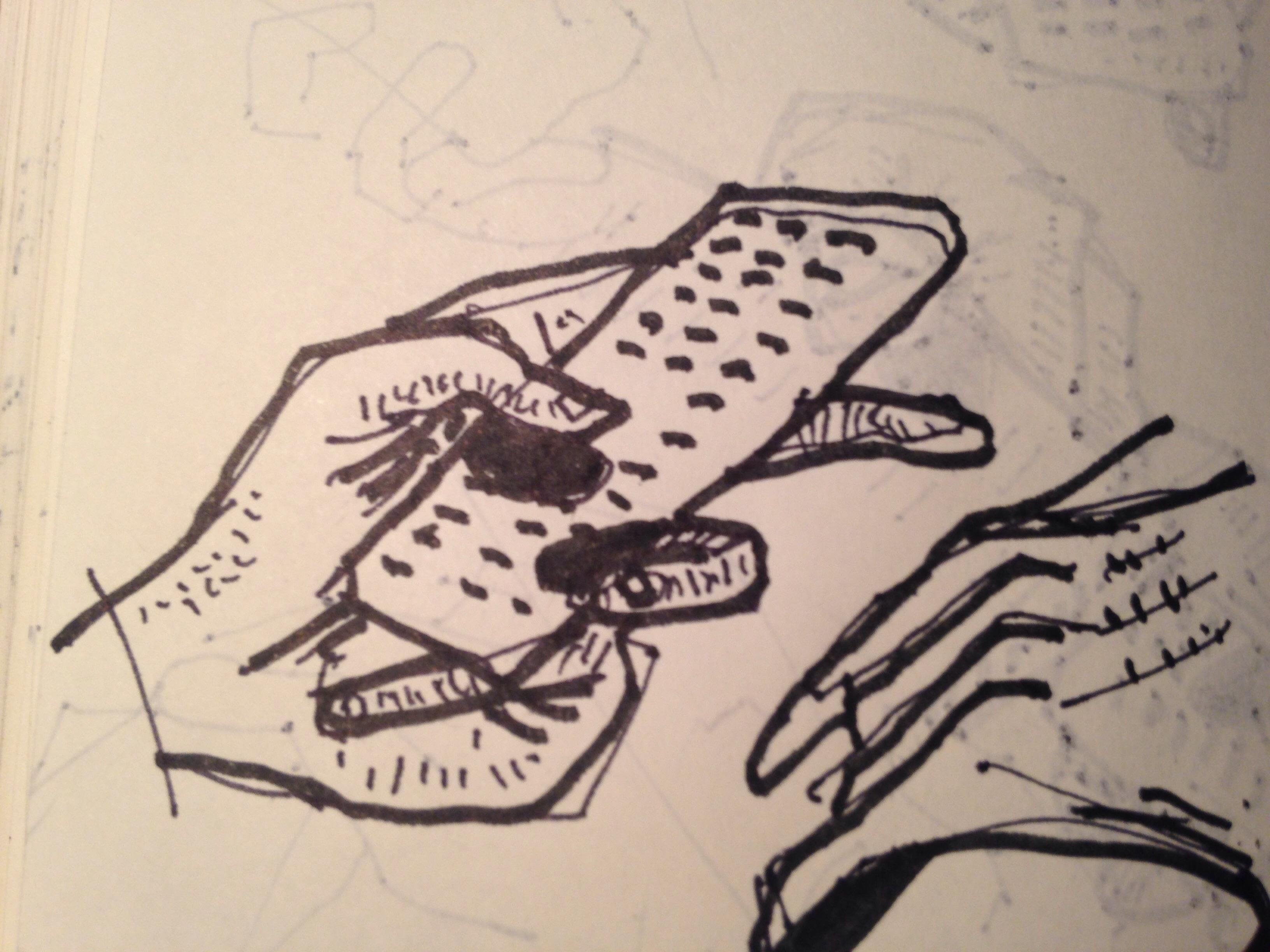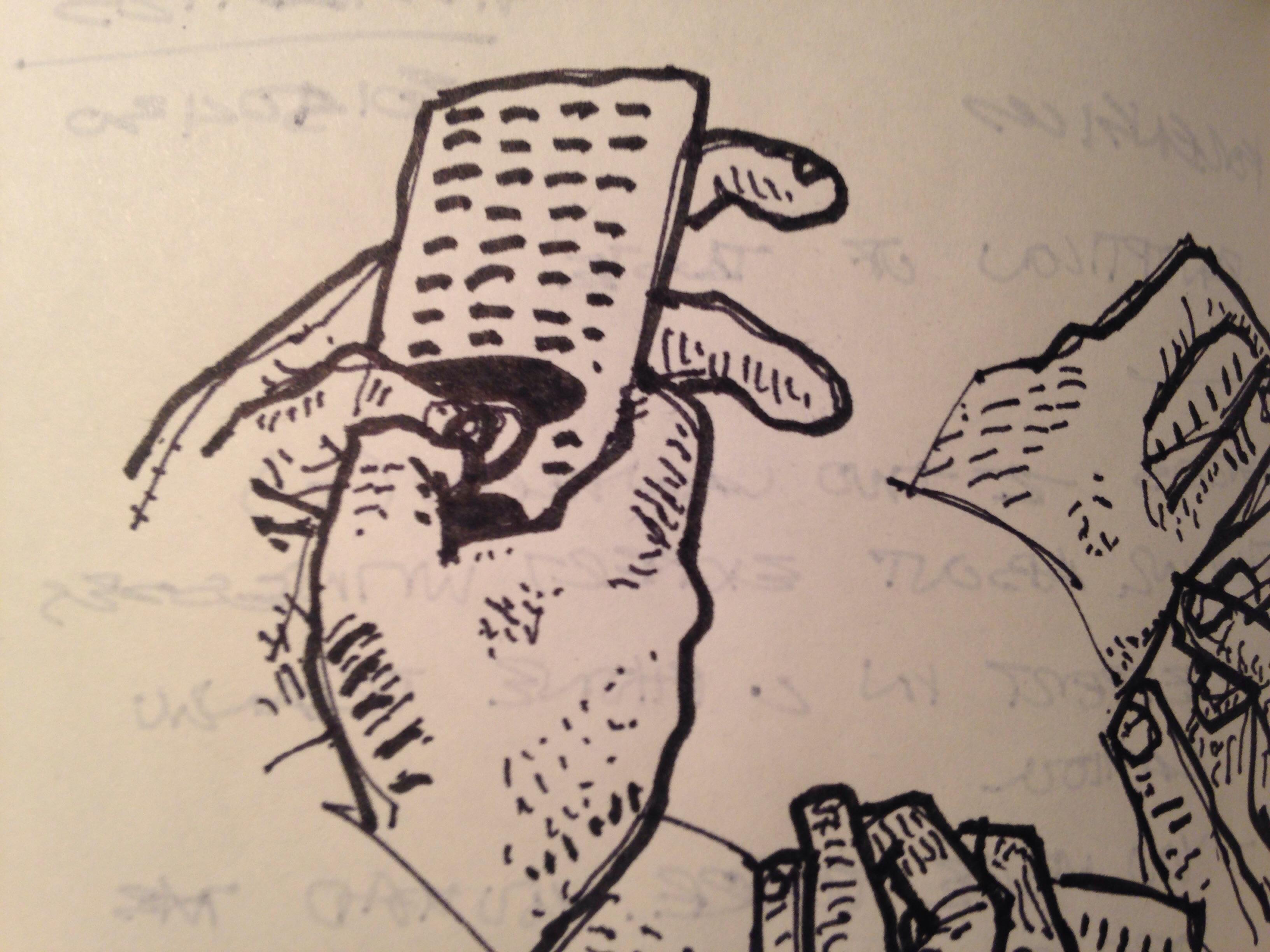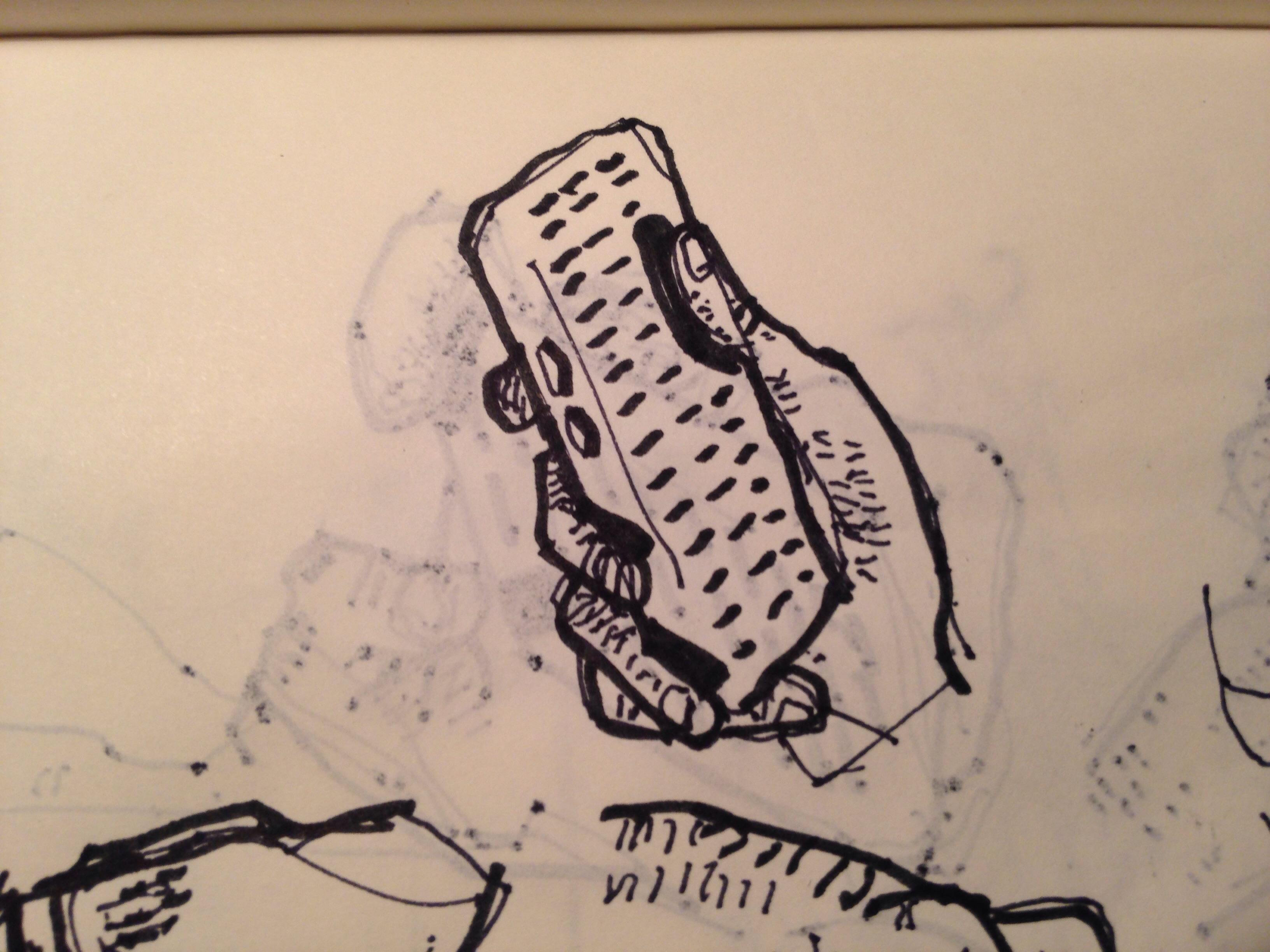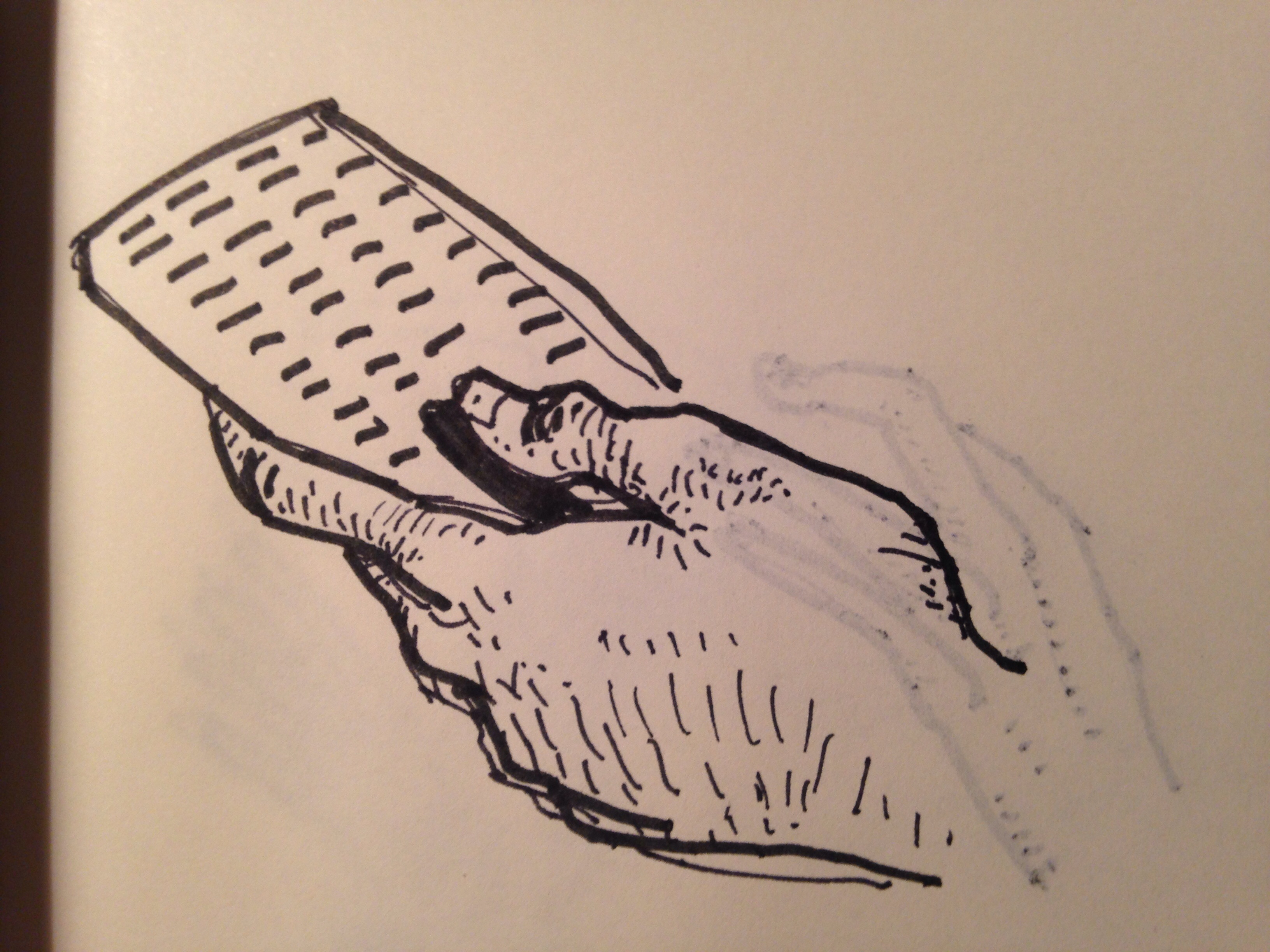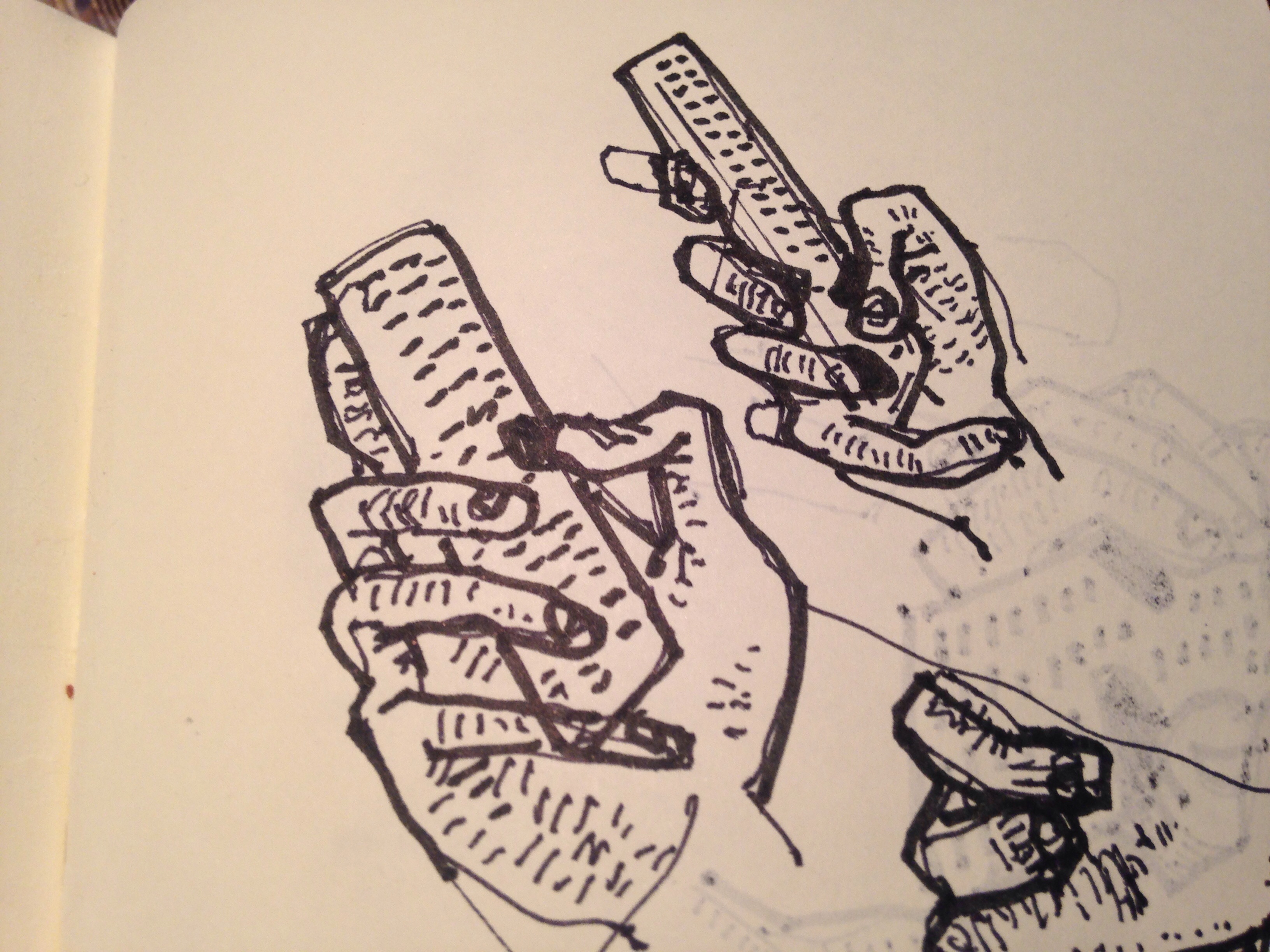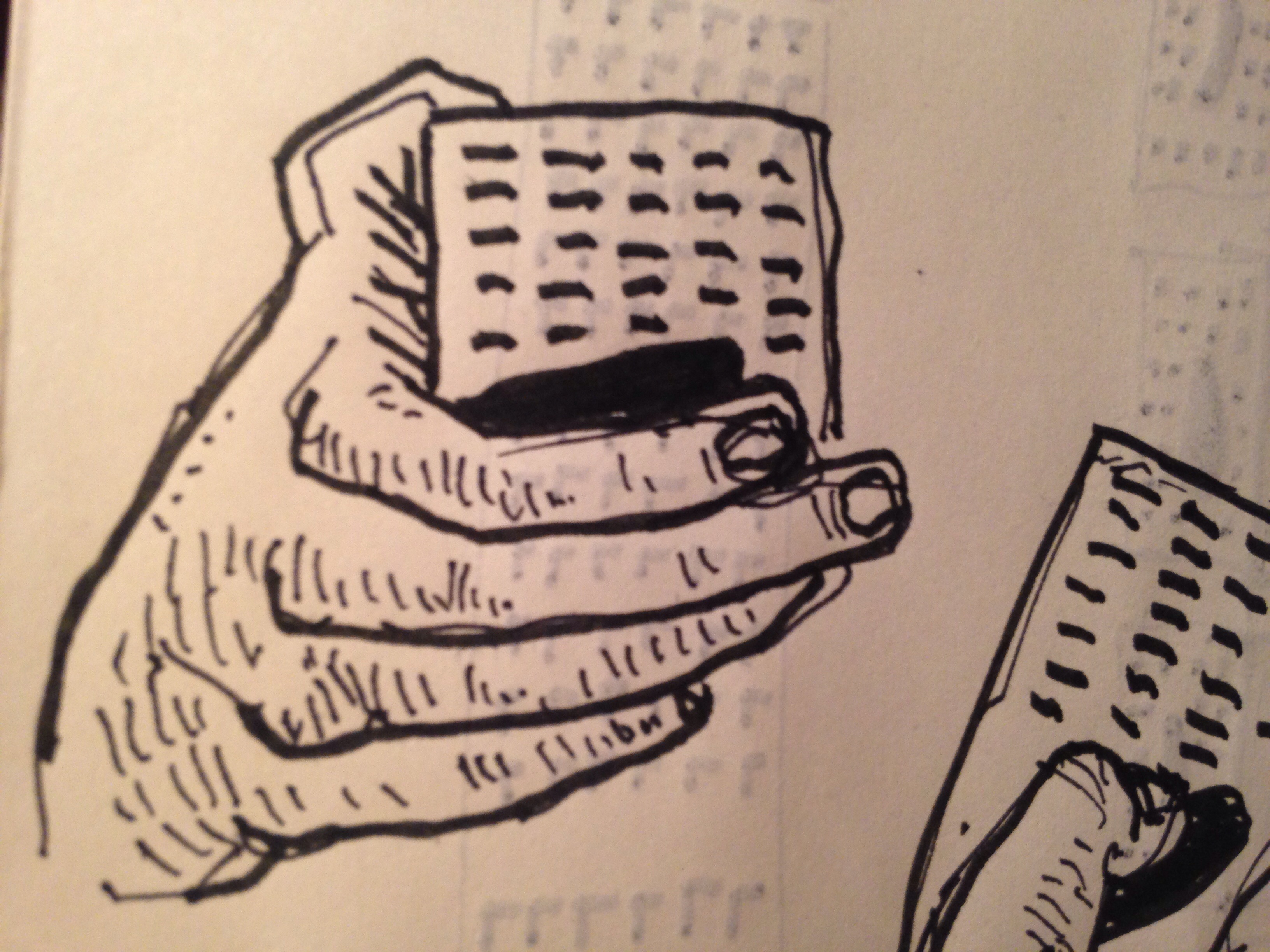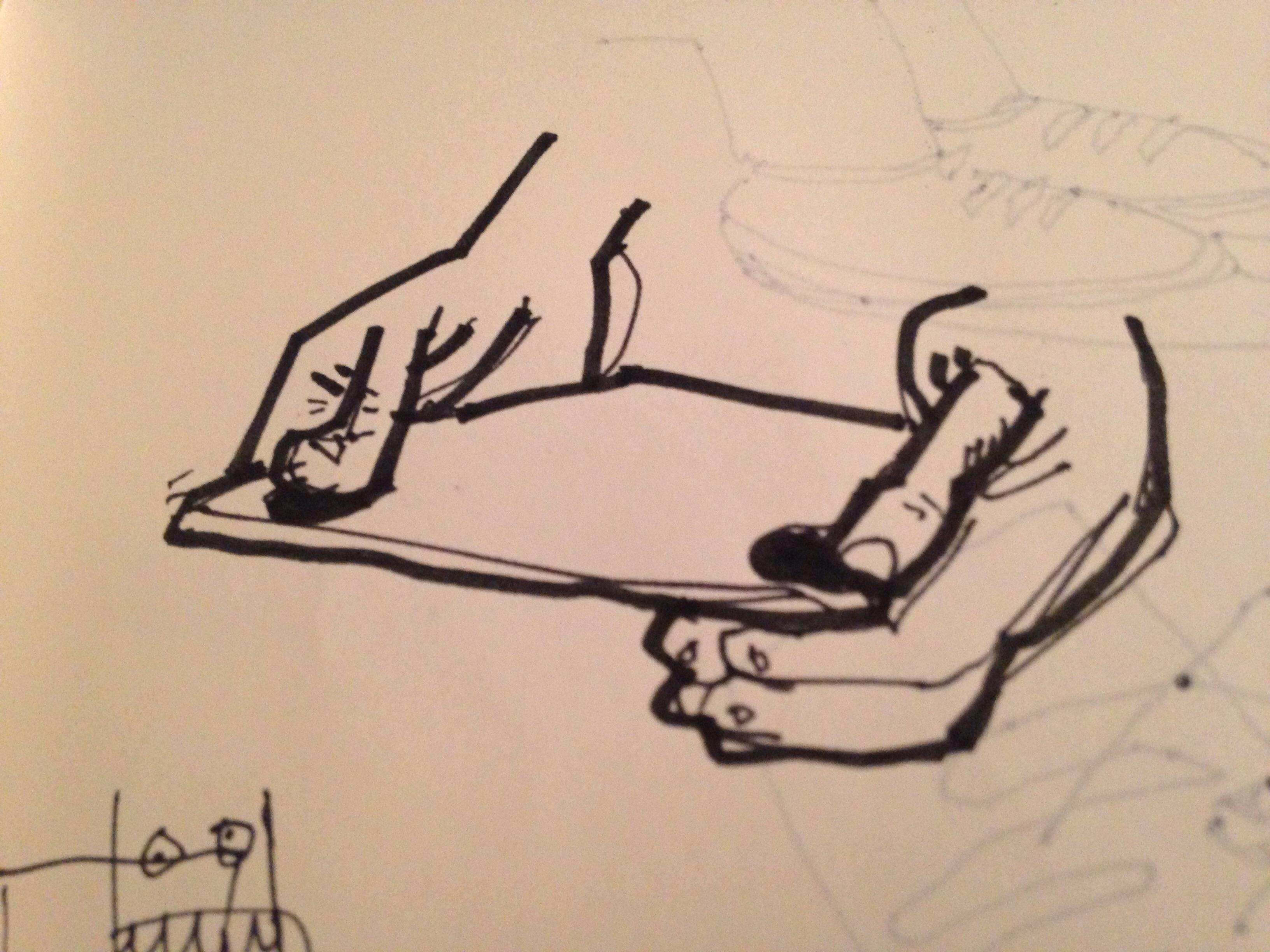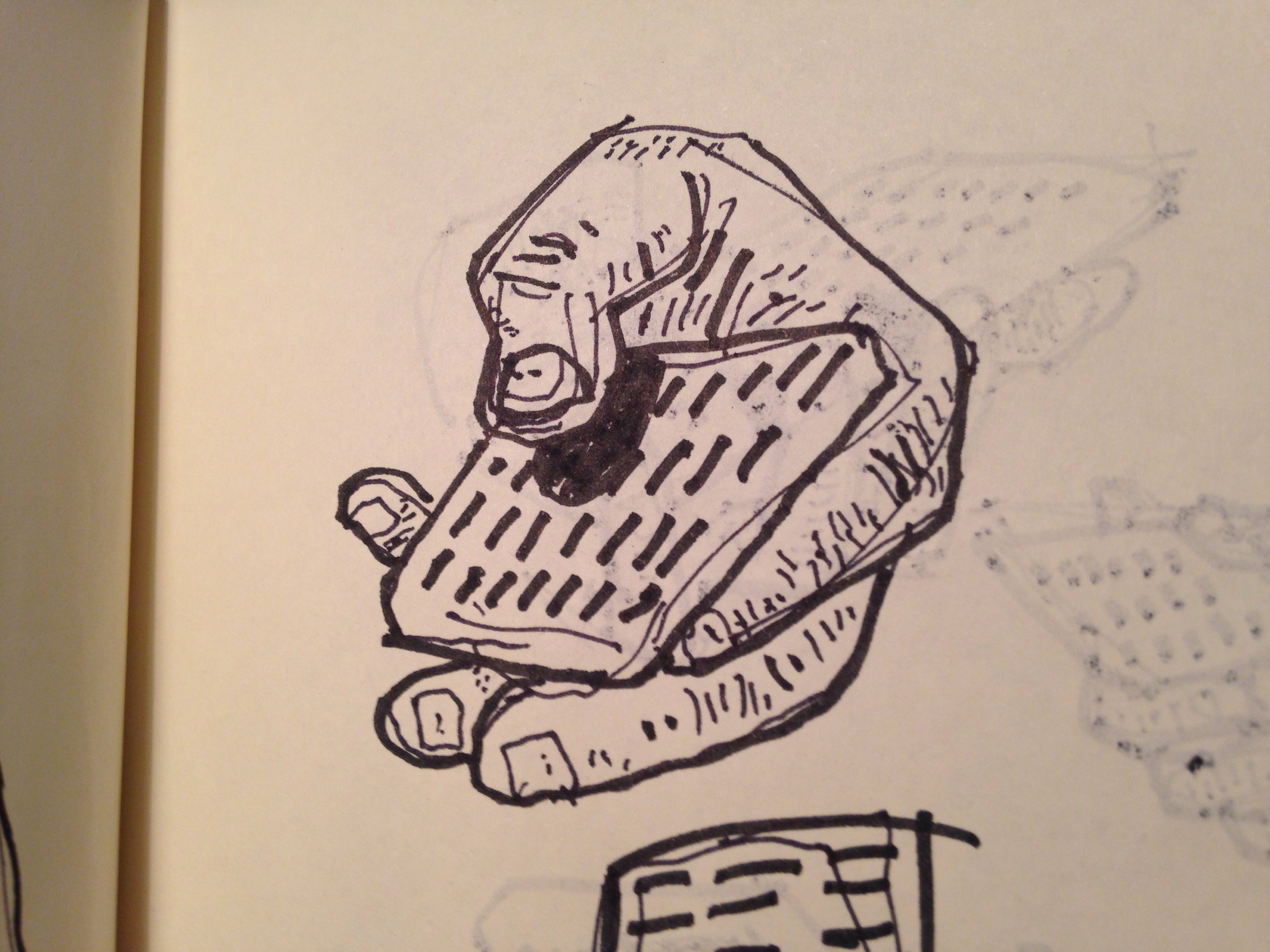Always be talking about the Pen...
Since doing a first Big Talk about the Pen, in Denver last March, I've done three subsequent talks
on the subject. The middle-bits and the
end are all more or less the same but each have
started a little differently. There are common themes
in all of these talks but each is different in its own
way. They are presented here not as a cohesive narrative
but because, as usual, it is the story I want to
remember.
In the time it's taken me to assemble this blog
post a colleague asked whether the Cooper Hewitt had a
digital strategy document we could share. If we had
one Seb never bothered to share it with me which is
just as well since I am mostly allergic to them or at
least choose to act as though I am. This is what I said instead and
I am including it here because it nicely synthethizes a
lot of what I was trying to get at in the talks below.
Make digital part of the executive. This is all
still so new (at least in the museum sector) that it
needs the love and care and the shit-umbrella of the
director lest the whole thing get swallowed up by
the internal politics of the organization.
Build internal capacity. Read: Hire warm bodies and treat them as your
own. This doesn't preclude third-party contracts but none of this stuff is
self-assembling. The sector has a bad habit of believing that the place to
standardize things is in the mortar, so to speak, rather than the bricks. The
results not surprisingly have ranged from hilarious to a galactic waste of time
and everything in between. Bricks are totally worth standardizing on. Mortar
itself may be something to standardize on but its application is worth paying
someone to do on a case-by-case basis.
Adopt the gov.uk motto that the
strategy is delivery.
Which is a friendlier way of saying "just fucking do it" which really means that
the people _in_ digital do not have the luxury of faffing around for six months
(or longer) because the most important thing for an organization to see in the
early stages is proof of an idea. Everything we did at CH was really hard for
people to wrap their head around in the beginning because it was so
new.
Aspirational PowerPoint slides do little to help with that dynamic after a
certain point. It was hard enough to demonstrate what we were trying to do with
the infrastructure we had (or were building) and it would have been impossible I
think without it.
Make the cost of failure as important as the cost of success which is to say
as low as possible. That is the reason for all the points above. Even if it's
just internal failures in the service of a larger project figure out how to make
them so "cheap" that everyone understands them to be the acceptable cost of
determine what success is. Then figure out how to do that in public.
...
I suppose in that regard the collections website
is/was/remains the "strategy document" you speak of.
It was the proof, the reminder and the opportunity of everything we were trying
to do. The details will be different from museum to museum but to the extent
that we all have collections and most of us think affording access to them is
important the digital manifestation of those collections is a tangible way for
an organization to demonstrate the arc of its intentions.
I guess that's why I was saying "figure out a way to do it in public" which
really means finding a way to let people work
through an idea (about the meaning and purpose of
the institution they are part of) without having
to always worry about saving or losing face.
And this is what I said before that...
press and hold to save (RFID World)
The second of the three talks was in San Diego at
RFID World, an industry conference, in mid-April. It
was a quick trip and I spoke on the weird first-but-not-really-part-of-the-conference day that so many
events suffer from. Basically it was
supply-chain and inventory management people, the
Army, the NFL (think the
Superball Twitter account pitch that Stamen did
way back in 2010) ... and
me.
I also opted to go
watch the first game of the hockey playoffs,
surrounded by what I assume were ex-pat Canadians in the employ
of the military-industrial complex, instead of
attending the opening keynote by an Army general
which is presumably why I will never be granted any
kind of security clearance. As I write this, a month
later, I see that Army-guy was replaced
by someone from something called US
Transportation Command
so... yeah.
I'd like to start with a quote by the Taiwanese author Wu Ming-Yi: Her voice infused people with the essence of a
song. It would turn into a windblown seed: you never
knew in your heart where the seed would fall, nor when
it would sprout.
This may seem like an odd
quotation for an industry conference about location
tracking, pervasive identity and generally solving for
who's on first. I like this quote because it nicely
describes some of what — and why — we are
trying to do with the Pen.
I grew up in Canada.
Canada does not have the kind
of creation myth, or foundational purpose for being, that a country
like the United States does. No one has trumped the US
when it comes to creation stories but Canada
was birthed, at nearly the same time, entirely in the
service of economics and geopolitics. Canada was created first in the service of
the merchant classes and second to ensure that a
British railroad reached the West Coast before the
Americans thus preventing them from going North. Or
maybe the other way around, but you get the idea.
Despite all the Canadian Heritage Minutes that have
been produced in the intervening years it's not really
an inspiring start. What is interesting about
Canada though is that it's managed to do pretty well
despite its generally crass beginnings. Canada is not
without problems but, at least in modern times, has
managed to create a social body that mostly
works most of the time for most of
the people.
It sometimes seems that the most critical
thing people can say about this arrangement is that it
is boring
but we'll save a discussion about
people being adrenaline junkies for another day.
It is important to mention that in Canada most
anything has historically mostly always been to the exclusion of the First
Nations for mostly everything. Canada's relationship with the First Nations,
until recent years (and still now in some cases) can
only be described as appalling and shameful. Since I started
writing this blog post the Truth and
Reconciliation Commission of Canada mandated to
tell Canadians what happened ... and to create a
permanent record of what happened in the Indian
Residential Schools
has been published. I have
not read the
findings yet but I will and so should you.
Note: This is the official Smithsonian logo but just in
case there is any confusion this is not the
official Smithsonian motto. Anecdotally, though, this
would be the most popular staff t-shirt ever printed.
I started with a story about Canada because I see
parallels in the origins of the Smithsonian. The
Smithsonian was not an American
creation but
rather the unwanted dream of an English businessman named
James Smithson. Sasha Archibald's The
Difficult Bequest: A History of the Smithsonian"
in the LA Review of Books sums it up nicely:
The Americans didn’t ask for Smithson’s charity,
and neither were they glad to receive it. Congress
had more pride than greed, and the unexpected gift
rankled: not only was it that of a reviled Brit, but
a Brit who dared demand he be acknowledged in
perpetuity. Moreover, it was earmarked for a purpose
Americans never would have chosen
themselves. Smithson’s patronage was condescending —
nothing more, one Congressman surmised, than a rich
man’s bid for immortality. Even John Quincy Adams,
the bequest’s most passionate advocate, refused to
venerate Smithson as a magnanimous patron. It was
Adams who kicked up a fuss when investors were
allowed to squander the funds (later replenished by
the US Treasury) and Adams who protested that a
national farm didn’t meet Smithson’s
stipulations. In private, however, he concurred that
James Smithson was probably insane.
But you know 169 years later the Smithsonian has
evolved in to something pretty awesome. We
have all the stuff or, more precisely, 137
million objects and counting. The
Smithsonian is a public instution with a mandate to
act as a public good and there aren't many
other cultural heritage organizations that operate at
the scale or with the breadth of the Smithsonian.
I also like to joke that the Smithsonian has the
world's largest conceptual art collection. The good
news is that there really are 137 million objects and
they are actively being cared for. The bad news is the
only real proof of this that you, as a citizen, have is a leap of
faith when I, as an employee of the Smithsonian, tell
you these things are true.
That's the larger context that the work we've been
doing around the Cooper Hewitt's much smaller collection website operates in. We
have 217, 000 objects and have been using the collection
website, and the idea the every thing of importance to
us has a stable and permanent URL, as a
device for people to have common referent
— something they can share — for
the real-life objects they may not ever be able to see.
The collection website is also the scaffolding on
top of which all the work that we've done for the
museum's re-opening sits. If the macro-question is how
do you provide access to the entirety of a collection
the micro-question is: How do you provide recall for those
parts of a collection that are actually on display?
What if you could come to the museum and remember
your visit without having to spend half your time
futzing around with devices to cobble together a
half-assed and short-lived memory?
Think: Taking pictures of wall labels or taking
pictures of objects without necessarily knowing what
they are or who did them or how you figure those
things out once you've left the building.
Which is why we built the Pen.
JFDI, a love story (Museums and the Web)
The first of the three talks was done jointly
with Seb Chan, at Museums and the Web
in Chicago in early April. This was the talk to
accompany the thirteen-thousand word
paper we co-authored about the Pen and all its
related infrastucture. Seb set up the talk as follows:
- Seb talks
- Aaron and Seb argue
- Aaron talks
- Aaron and Seb argue
- Questions and answers (in the form of Aaron and Seb arguing some more)
Which is pretty much what happened. This is what I said:
In about Decemer of 2012 we launched a public API
for the collections website. It didn't actually take
us three months to build the API. It took us three
months to decide that it should be at the top of the
TO-DO list.
At the beginning of February 2014 there was, for all intents and
purposes, no pen. If you had asked us to
demonstrate the Pen we would have only been able to
show a whiteboard marker with an RFID tag taped to it
and a Raspberry Pi with an RFID antenna and a single
hard-coded object. There were other efforts in play that
ultimately came to pass but at the beginning of the
month there wasn't much tangible to demonstrate.
This is a exagerated but not inaccurate
description of what all of 2013
looked like.
By the end of February 2014 we would have not one but two
different functional prototypes for the Pen and less
than a year later we managed to design, produce and
manufacture custom electronic hardware from scratch. (The finished pens arrived at the
museum a few weeks before they went out on the
floor.)
There are two lessons to take away from this.
The
first lesson is: It turns out that it's possible
to do this kind of thing in 2015. It turns out you can
do capital-P captial-D product design and manufacture
something in a meaningful volume — say more than
20 or even 100 and less than 500, 000 — for
a reasonable cost.
It's still really hard, requires a
stupid amount of work, no small amount of shouting at people and
a not insignificant capital investment. It was more than
lunch money but it was not an irresponsible amount of
money and if you imagine that the work we've done
might some day be deployed to every other
Smithsonian museum on the Mall then
the costs start to seem laughable.
There is no plan
to deploy the Pen on the Mall yet but we should. The
implementation details are non-trivial but
it's totally do-able (really) and would be a good way for the
Smithsonian to exercise and exorcise some of its
institutional demons and generally just be
awesome for everyone else.
The second lesson is: Don't do what we
did. Don't try to do this in a year. It's
possible but there is no valour in the
burden we took on. It's a stupid way to work but we
(the museum) had painted ourselves in to a corner from
which the only escape was to walk back out again, painting
over our footsteps as we went.
I choose to see our decision to
suffer that indignity as proof that the Pen was worth
doing but that's also the point: The Pen was worth doing on
first principles not because we have War Stories to
tell after the fact.
The reason I mention all of this is that the
constant throughout this entire process was the
collections website and the API which are really the
same thing. I sometimes hear people saying that
APIs are hard
and I am pretty sure I don't
agree with that. We launched our API three months
after the collections website and a full two-years
befor the musuem re-opened.
This is important. An API is not a finished
anything. That's the point. An API is
access to data in the service of an idea that does
something. I think there is a popular myth
that when an organization publishes an API it will
somehow magically self-assemble in to a finished
product adored and embraced by the masses.
I think that a more useful way to understand APIs
is that they exist to allow other people to build tangible
proofs without needing to badger you all the time for
the details.
Okay, this is where it gets a bit murky. I did
not have prepared notes for this talk so as I look
back, two months later, I know what I was getting at
but I don't remember any of the exact phrasing.
It was also the shout-y and rant-y and potentially
impolitic part of the talk. Impolitic because I was
trying to highlight some of the problems we
encountered working with third-party
(client-services) vendors on the project.
The problem with doing that is that, of course,
people might think I am talking specifically about the people we
worked with. Which I wasn't then and I am not now. Every single person who
was involved in the museum's re-opening has their
own set of gripes and grievances and War Stories but that's not what this is about.
I have no idea... I mean I know exactly what this
slide is about but I don't remember how it fits with
this talk...
Uh... It's a good pull-quote, at least.
Here's what happened: The Pen began life as a
concept slide.
This happens all the time. Design firms take
their clients to the far edge of the near-future as
a kind of brain-storming exercise. The point is not so much
that these concepts will see fruition but that they
will act as devices to help people articulate the
motivations and desires around a project. They help
define the narrative and the meta-project.
The problem with the Pen was that it
pointed to something that the museum wanted to be
not the meta-narrative but the narrative itself:
Recall and license. The problem with the Pen was
that the only way to genuinely achieve those things
was... with the Pen.
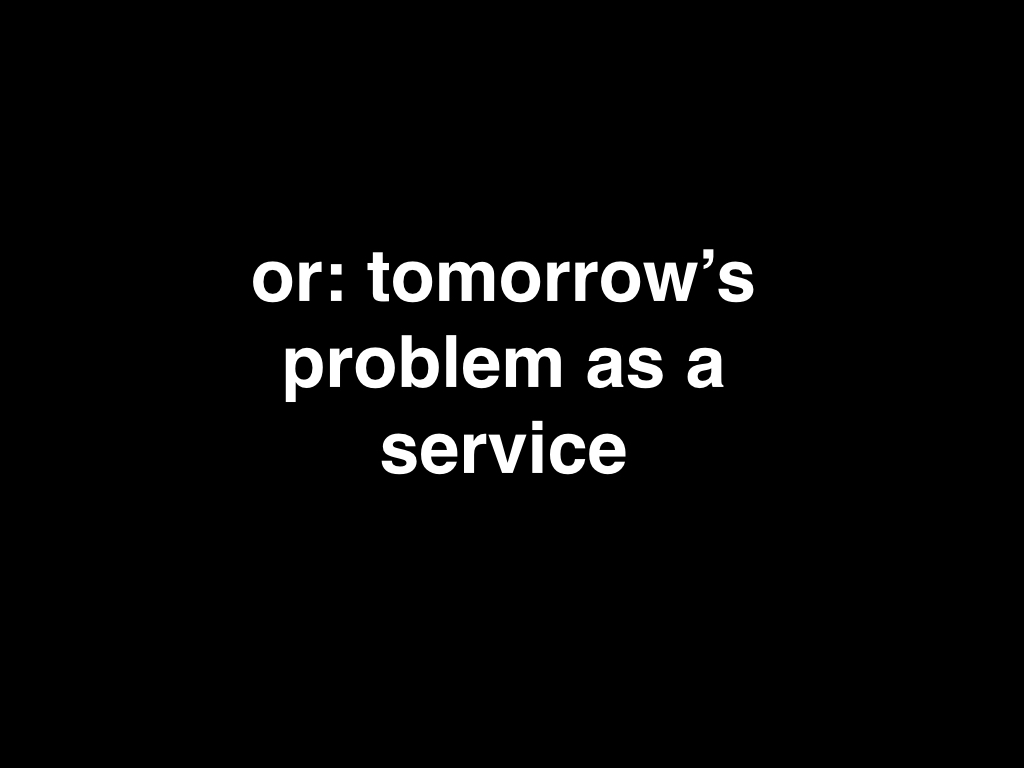
The problem with the Pen was that, in
2012, it seemed like something that ought to be
do-able with enough money and enough smart people
and enough hard work. The problem with the Pen was
that the realities of producing it (and producing it
for use in a museum with a heterogenous audience and
open 363 days a year) were really really complicated.
The problem with the Pen is that it was such a
good idea that we (the client) wouldn't let it
go. Eventually this made for some awkward
meetings when we would not stop asking how and when the Pen
would transition from a two-dimensional rendering in a
presentation to something we could hold in our hands
— a tangible proof. This was a complicating
factor because the idea and the aspriation was meant
to be the proof
while its execution was
always tomorrow's problem.
Eventually this disconnect reached a point where
the realities of the re-opening schedule meant that
every day the Pen was still the sum of all
possibility spaces it became harder still to imagine
completing. That's what I mean when I say: Don't do
what we did.
Or rather: Instead, foster the
institutional capacity (both for yourself and your
contractors) to minimize the wait-time between a
concept and something that works, no matter how
clunky it is. If the goal is to short-circuit the
institutional inertia that accumulates around a big
and terrifying and risky project then the goal is
really to minimize the cost of failure.
Also it helps to be able to call bullshit in
meetings. It's not fun but it saves a lot of hassle
down the road. Ask me about this slide, some day. This actually
happened and it was a profoundly
depressing moment but I am not going to get in to
the details in print. Let's just say that I was always ready to believe
that the Pen was too hard to do. I just never
believed any of the reasons I was given.
This is not about the client-services model
itself. There is nothing wrong with the
client-services model and lots of good work has
been produced under its umbrella. It is about the roles and responsibilities,
and their consequences, that museums have forged with
client-services companies.
It is about the reality that museums don't know how
to do the things they want to do and are entirely
dependent on client-services companies. It is about
the reality that museums don't even know how to
talk practically about the things they want to do
outside of magical unicorn deliverables or wishful
thinking or simply burning a problem away with
unsustainable amounts of money.
It is about
the reality that those same client-services companies can be
forgiven for not believing anything their clients say
(goals, funding, tolerance for risk) and for
ruthlessly pushing the work through a meat-grinder
tailored to their own schedules and capacities. That's
just business.
It is about the reality that if any one of those
dynamics changes there are outsized ripple effects on
all the remaining dynamics. If we're going to assign
blame or responsibility though I think we would do
well to start with ourselves: The sector has allowed
this to happen to itself.
For those of you who don't already know in a past
life I worked at Flickr for about a
million years. This is a slide I made to describe to way I
understood things to work at Flickr, circa 2009. One of the disconnects
between the way we worked at the way a lot of other
parts of Yahoo (who acquired Flickr in 2005) worked
was this idea of products
versus
features
. Most of Yahoo was instrumented to
treat features as stand-alone products and not just an
on-going extension or faceting of the original
product, in our case Flickr.
This is what most feature launches looked
like. If you were an engineer the two-to-four weeks
prior to launch were Pure Suck because everything kept
changing with less and less time to actually implement
those changes. Almost every part of the engineering
culture and infrastructure was designed to accomodate
this reality and it was a big part of our success but,
in the moment, it totally sucked.
This slide is incomplete, though.
So I think the lesson in all of this is as much
about lowering the cost of failure as it is lowering
the cost for success. The Pen was not as many, including the museum,
believed simply a question of snapping together a
suite of off-the-shelf hardware and software pieces
like a kind of cultural heritage Lego model. It was a
lot of trial and error shoehorned in to a brutal
schedule which meant a ridiculous amount of energy and
attention was spent worrying about getting something
right the first (and only) time. It's pretty great
that we pulled it off but the number of places the
whole project could have gone completely wrong and
failed were so numerous it is sort of a wonder that we
chose to do it at all.
Hail Mary passes are
exciting but they are a bad way to run a project.
The reason I started with a timeline of the API is
that in building out our own infrastructure, fast and
early, and likewise
maintaining it ourselves we have had a practical way
to build working prototypes as a means to address
unknowns and, more importantly, debate. Put another
way, we had a way to make the time and the effort
to disprove an idea or a concern or an outright
argument so low that any questions about testing it in the
first place were rendered moot.
Another way to see any discussion about the cost
of failure or success is to understand it as measuring
the cost of liability and the practice of
outsourcing risk
by delegating all
responsibility for anything that looks or feels like a
failture to third-party contractors. As a
practical matter though the cost of minimizing the
wait-time between a concept and something that
works
is very different for an organization than
it is for a contractor.
Those costs become even more pronounced when you
are dealing with something as complex, and as novel,
as the Pen was and continues to be. The following
passage is from the paper Seb and I wrote for MW and
tries to address the issue of those costs:
It is important to recognize the problems with
this model (a one-off innovation to a commodity –
ideally one which can be bought cheaper from a third
party supplier and supplimented with a support
contract that outsources liability and risk) when it comes to services-based projects
like The Pen and its ‘museum-wide’ system:
Support contracts are typically for projects
whose value diminishes over time (because on-going
development of a project stops at launch) and so
the cost of that contract, in effect, increases
year over year with fewer and fewer returns.
With support contracts very often no
institutional knowledge about the project or how
it might serve as a platform for future projects
is gained. Sometimes the only tangible skill an
institution learns, or passes on, is how to manage
contracts for service providers.
A support contract is only valid for past
work. Any additional changes or improvements incur
additional non-trivial costs because third-party
contractors not only need to complete the work but
require time to familiarize themselves with a
pre-existing code base.
Support contracts represent money that
leaves the institution and never comes
back.
These overall costs are likely to be much more
than it would cost to hire and maintain permanent
creative technical staff in a museum when
intangibles like institutional knowledge and the
ability to build on the value – technologies,
learnings, especially created by past work – are
factored in.
As a sector we have spent a couple of decades making excuses for why “digital”
can’t be made core to staffing requirements and the results have ranged from
unsatisfying to dismal.
The shift to a ‘post-digital’ museum where “digital [is] being naturalized
within museums’ visions and articulations of themselves” (Parry, 2013) will
require a significant realignment of priorities and an investment in people. The
museum sector is not alone in this – private media organisations and tech
companies face exactly the same challenge. Despite ‘digital people’ and
‘engineers’ being in high demand, they should not be considered an ‘overpriced
indulgence’ but rather as an integral part of the already multidisciplinary
teams required to run a museum, or any other cultural institution.
The flow of digital talent from private companies to new types of public service
organizations such as the Government Digital Service (UK), 18F (inside GSA) and
US Digital Service, proves that there are ways, beyond salaries, to attract and
retain the specialist staff required to build the types of products and services
required to transform museums. In fact, we argue that museums (and other
cultural institutions) offer significant intrinsic benefits and social capital
that are natural talent attractors that other types of non-profits and public
sector agencies lack. The barriers to changing the museum workforce in this way
are not primarily financial but internal, structural and kept in place by a
strong institutional inertia.
Good times.
The panopticon of taste — a cultural heritage
of plausible deniability (Data and Society)
The third and final talk was for the Databites
lecture series at the Data and Society
think tank. This one was different than the others
because I wanted to use the Pen to talk about the
weird overlap between the cultural heritage sector and
the security or surveillance state that modern life,
and its motivations,
forces in to question. The pull quote for the talk was
Why the cultural heritage community is jealous of
the NSA
so in that way it was more like
the
talk I did at the MoMA R&D Salon back in February.
I did not have narrative
slides for this talk. The series organizers encourage a short
introduction with the bulk of the event spent having
an active conversation with the audience so I put
together a set of drawings (that I made on the subways
going to and from work) to run on an automated loop
in the background as a kind of soundtrack music. I don't know how succesful it was but it's what I
did. I have included my introductory remarks scattered
throughout.
There will be video of the talk and the Q&A posted soon enough The video of the talk is online so you'll be
able to compare what I actually said with my
remembering of what I meant to say below. As is my habit, I started with a pair of non-sequiturs.
Years ago, I read an interview with the director
Hal Hartley. If you've never seen any of his films
they are punctuated by a noticeably weird and unnatural style of
speaking employed by all the actors.
Hartley talked about how, following an argument,
many people spend days and days, thinking of the
perfect come-back or rejoinder to something that was
said to them. I try to write my dialog,
he said
as if each character had that perfect come-back on
the tip of their tongue everytime they spoke.
One of the things I've been trying wrap my arms
around is the belief, in almost all large
organizations, that a project once launched will never be
revisited. This is especially true in politics or at
least perceived to be true, which might be worse.
Despite all the arguments someone else might make
in its favour there persists an institutional cynicism
that version two
of a project will never
happen.
As a consequence everyone tries to shoehorn their
part of a project in to version one
with all
the corresponding complexity and bloat and politics
you might imagine that entailing.
You can see a parallel to these phenomenom in the
way that museums think about visitation and, in turn,
visitors think about museums. In short: The belief
that everything needs to be crammed in to a too-short
90-minute visit and it all needs to be meticulously
documented as a consequence since the whole experience
ends up being like a cultural heritage version of shock and awe.
There is a spectrum (of both museums and visitors)
of course but what underlines both activities
is a belief that the museum and the museum
visit will never be returned to in any capacity once someone walks out
the door.
There is ample evidence to back up this
observation but what if you could come to the museum
and then leave with a record of your visit that didn't
demand you spend half your time futzing around with
your phone or some other device
?
How would that change the ways that you observed
and interacted with the objects on display and how
would that changes the ways that the museum interacted
with you?
What if you could go to the museum and have the
confidence of memory or recall? What does it mean for
a museum to say to its visitors We'll keep a record of your
visit and make it available for you to re-visit at
some later date
? We won't preserve it the way that
we do the objects that have been accessioned in to our
collection but otherwise it's no trouble.
Maybe that is what part of what being a museum in
2015 means. Certainly for a public institution like
the Smithsonian I think there is reason to think
that's what it should mean. Our entire purpose is to
keep things safe, after all. What if we extended that
courtesy to your visit?
So that's why we made the Pen.
Which is in many ways just a very elaborate
physical bookmarking system. People, it turns out,
like to bookmark things.
In a world where everything is measured against the
benchmark of Facebook's or Google's scale and success
our numbers are pretty humble. On the other hand if
you compare the those numbers to the numbers we used
to enjoy — attendance, dwell-time, repeat
visitation or any indication that a visitor didn't
immediately turn to dust the moment they walked out
the door — it's been a raging success.
The figure that I often mention is that, in the
less than three months since the Pen has been
available to visitors, there have been just shy of one
million act of collecting
. Which is pretty cool
considering that there are only about 700 objects on
display in the museum itself.
And of those million acts of collecting visitors
have collected 3, 900 different objects. When you look
at the numbers it is absolutely clear that most of the
things that people collect are collected from the wall
labels, rather than the interactive tables, in the
galleries. I can't be bothered to do the math to
establish whether it's really an orders of magnitude
difference simply because the numbers are so extreme.
But think about it:
Most things are collected from wall labels but there
are only 700 objects on display but 3, 900 distinct
objects have been collected.
Part of the workflow for any new exhibition
involves the curators choosing, for every object on
display whether its a loan object or one of own, up to
ten related objects from the collection. What
related means is left up to the curators and the only
criteria is that an object on the floor exists within
a larger context or institutional velocity.
In addition the curators were asked to tag each one
of those objects (on display and related) using a taxonomy
of their own choosing. And this is not meant to be
a one-off either. We do this now for every new
exhibition going forward which means we are
always supplementing and improving past work.
That people are collecting 3, 200 objects not even
on display in the galleries points to the larger
opportunity in doing something like the Pen.
Every act of collecting an object (or of creating
your own on one of the interactive tables) has a
permanent and stable URL. What that offers both the
museum and its visitors is a tangible and practical
scaffolding that affords each of those permalinks
the same possibility to serve as a resource the way
the interactive tables do in the galleries.
This is not work we've done yet nor it necessarily
obvious, easy or inevitable. We have been a little
busy just making the basics work but we have always
done that work with an eye towards what it makes
possible next.
During the question and answer for this talk
someone asked me what we thought our visitors would do
with all of the stuff they collected. My answer to
that question has always been: We have confidence that
our visitors will figure out what to do with it on
their own terms and for their own reasons.
The list of things that you might hang off any one
permalink for an object collected is mostly limited
only by the time and typing required to implement it
so I don't get hung up on any one specific thing. We
should do all of it.
The bedrock of cultural heritage is debate and
nuance. Neither of those things square well with the
demands of architecture nowhere better seen than in
the practice of asking people with decades worth of
theory and practice to reduce their knowledge to a
scant paragraph taped to a wall next to an object.
Rather than trying to usher in a paradigm shift in
the realities of physical space the Pen, and all those
permalinks, offers a middle ground. There is still a
primacy in the object itself (even if that object is a
device for a larger social gathering or event but now
it shares that space with recall) with the safety of
staying present in the moment confident that it might
be revisited later, with the luxury and the
convenience of being able to choose what later
means.
Maybe later
also includes the ability for
museum visitors to contribute to the meaning of an
object or an event. As a design museum we increasingly
traffic in things that are literally hollow shells
without the software or the data that runs
them. Privacy details aside, what
if you could donate the data your Nest thermostat
collected to sit alongside the same hunk of metal and
plastic (and concept sketches) that we have sitting in our collection? What if
there was a way for you to participate in the meaning
of that object?
Which is all fine and good for museum objects,
right? I like to think so. This is what the fruits of 2015, all of this
amazing technological capacity to suspend time, make
possible. The batteries not included
part of that
equation though is the social contract around that
kind of recall.
Pretty much everything I've just
described, done to foster learning and understanding
in and of the arts, is also being done by big
companies and intelligence agencies alike. If Edward
Snowden is to be believed then it is being done by the
latter at a scale and with a reach that sometimes
exceeds imagination.
Let's assume for the sake of argument that the
stories told about the NSA's ability to record and
recall history are true. Let's assume that their
ability to weave tapestries of meaning out of nuance
and innuendo is unparalleled. When all of that attention is directed
at any one individual they might be forgiven for
thinking the whole project is a little sinister.
When you remove the sting of present consequences
the ability of these organizations to record your
visit
so to speak starts to look not just
attractive but beneficial in the long run. In some
distant future where our present is just a shadow of
its current concerns they will thank us for our ability
to preserve ancillary materials associated with a
subject and of instrumenting the cost of following
hunches and generally spelunking
through the mass of data to the point of seeming negligible.
These are not the issues that governed the Pen, or
the museum's re-opening, but
they are the places where the Pen overlaps with the
present. These are not tomorrow's problem.
